The forelimb of a dog is divided into four different segments. Here, you will know the answer to the question – ‘what are the segments of the forelimb in dogs?’
Quick answer: The shoulder girdle, arm, forearm, and manus are the four forelimb segments in dogs. These segments consist of specific bones of the forelimb.
I will show these four segments of the animal forelimb with a diagram. After completing this article, you will be able to identify the segments of the forelimb with bones practically.
What are the segments of the forelimb in dogs?
The dog’s forelimb is the appendicular part of its skeleton. It consists of the scapula, humerus, radius, ulna, carpal, metacarpal, and phalanges bones.
There are four segments of forelimb in the dogs –
- Shoulder girdle or pectoral girdle,
- Arm or brachium segment,
- Forearm or antebrachium segment and
- Manus segment,
Here, the dog’s forelimb-labeled diagram shows the different segments and bones. It shows the shoulder girdle, arm, forearm, and manus segments.
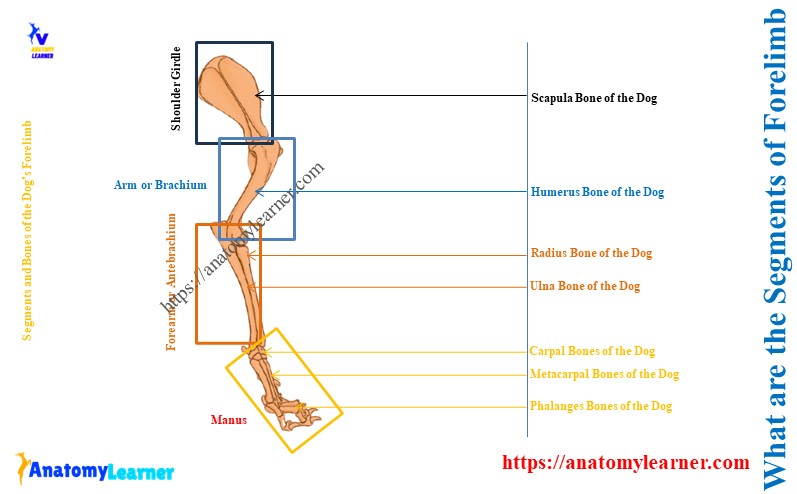
Again, Table 1 shows the summary of the segments of the forelimb in dogs with their bones –
| What are the segments of the forelimb in dogs | Bones in the segments of the dog’s forelimb |
| Shoulder or pectoral girdle | Consists of scapula, clavical, and coracoid |
| Arm or brachium segment | The arm of the dog consists of the humerus bone |
| Forearm or antebrachium segment | The forearm or brachium consists of radius and ulna bones |
| Manus segment | Manus of the dog consists of carpals, metacarpals, and phalanges |
What are the unique features of the forelimb bones in the dogs?
The first bone of the dog’s forelimb is the scapula, which has fewer unique osteological features than the ox scapula. Its lateral surface has a spine that divides it into equal halves.
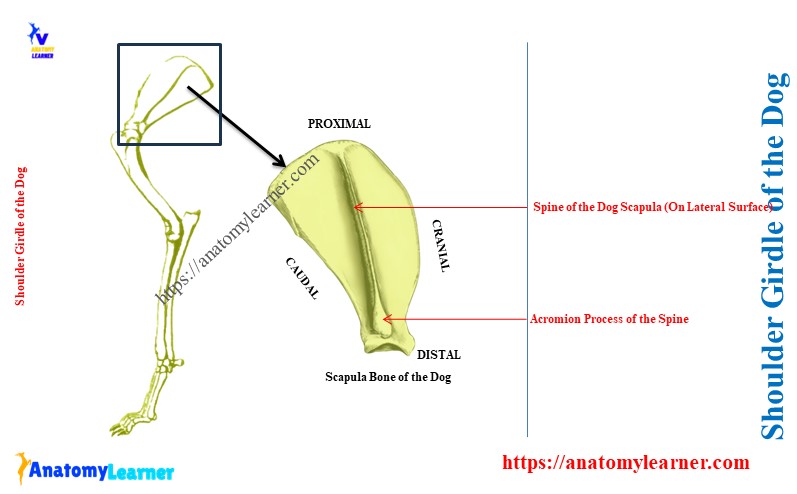
The tuber scapulae of the dog scapula are blunt, and the coracoid process is less developed. Again, the short and blunt acromion process extends at the level of the glenoid cavity.
The dog humerus bone is less twisted than the ox humerus. Its distal extremity has a large supratrochlear foramen that communicates between the radial and olecranon fossa.
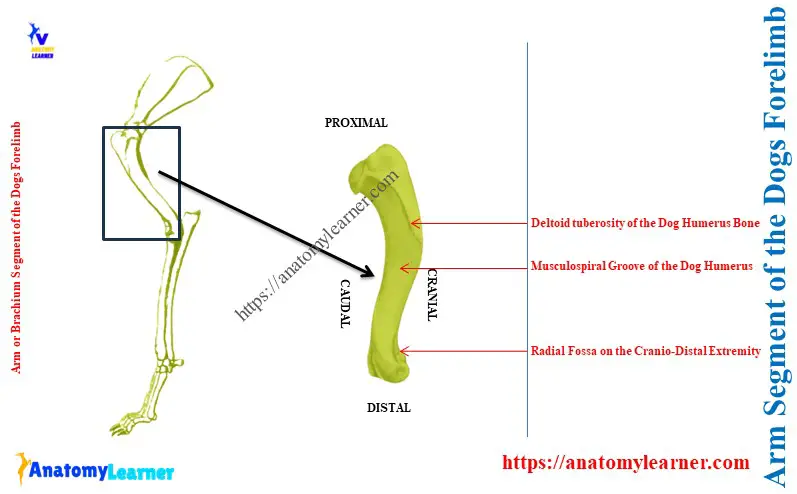
The musculosprial groove of the dog humerus is not prominent, and deltoid tuberosity remains as the ridge.
Compared to other animals, dogs’ radius and ulna are two well-separated bones. Thus, the interosseous space extends throughout the length of these two bones.
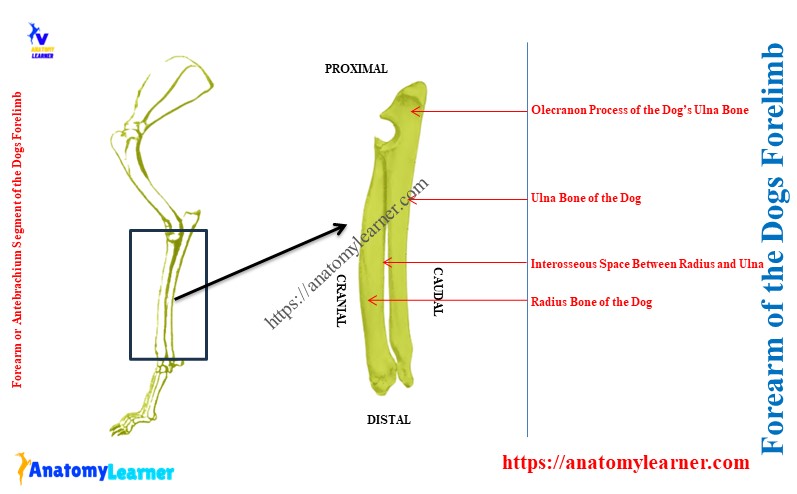
There are seven carpal bones in the dog carpus anatomy. These seven carpal bones are arranged into proximal and distal rows. You will find three carpal bones at the proximal row and four carpal bones at the distal row of the dog carpus.
Dogs have five developed metacarpal bones where the first metacarpal is shorter than others. Except for the first metacarpal, you will find the two depressions for sesamoids at the palmar aspect of the distal part of the metacarpal. The first metacarpal of the dog has only one depression for the sesamoid at its distal palmar aspect.
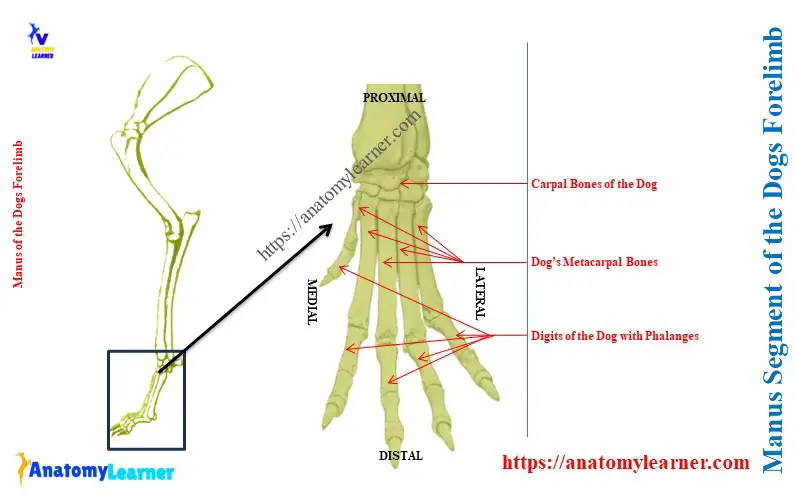
The first digit of the dog possesses only two phalanges, whereas the other four digits have three phalanges.
How many bones does a dog have in its forelimb?
Each of the forelimbs of a dog has thirty main bones and fourteen sesamoid bones. Thus, each of the forelimbs of a dog possesses forty-four (44) bones.
Let’s count the number of the bones from the dog’s forelimb. Here, Table 2 shows the counting of the bones from each forelimb of the dogs –
| Bones of the forelimb of the dogs | Number of the bones in a dog’s forelimb |
| Scapula bone | 1 |
| Humerus bone | 1 |
| Radius and ulna bones | 2 |
| Carpal bones | 7 |
| Metacarpal bones | 5 |
| Phalanges | (4 x 3) + 2 = 14 |
| Sesamoid bones Proximal sesamoid bones Distal sesamoid bones | (4 x 2) + 1 = 9 (5 x 1) = 5 |
| Total bones of the forelimb | 44 |
Here, the dog’s forelimb consists of fourteen phalanges and the cause is –
- The first digits consists of 2 phalanges (thus, 1×2= 2), and
- The other four digits consist of 3 phalanges (thus, 4×3=12),
Again, the number of the sesamoid bone in the dog’s forelimb is 14; this is because of –
- Proximal sesamoid for first digit = 1,
- Proximal sesamoid for other four digits = 2; (thus, 2×4=8),
Thus, total proximal sesamoid bones in the dog’s forelimb = (8+1) = 9,
Again, distal sesamoid bone for each digit = 1;
Thus, total distal sesamoid bones for the dog’s forelimb = (1×5) = 5.
Conclusion
So, there are four segments of the forelimb in the dogs which consists of specific bones. These segments of the dogs forelimb is important while studying the course of different vessels and nerves.

